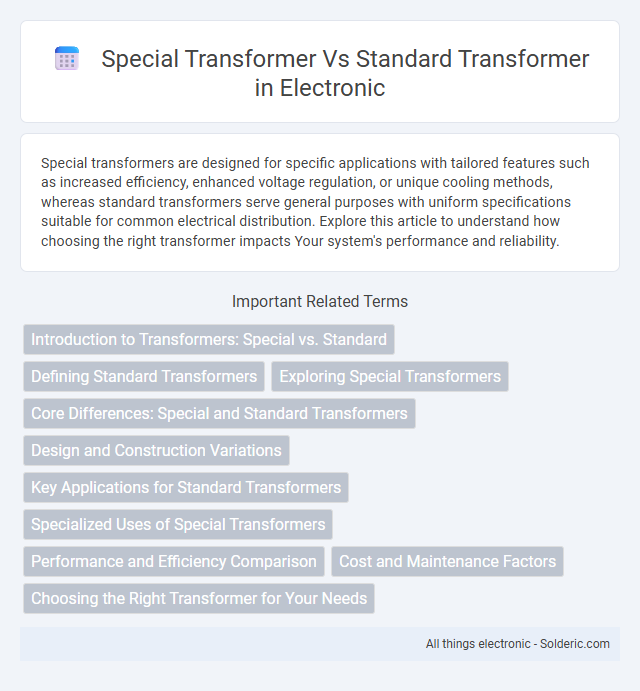Special transformers are designed for specific applications with tailored features such as increased efficiency, enhanced voltage regulation, or unique cooling methods, whereas standard transformers serve general purposes with uniform specifications suitable for common electrical distribution. Explore this article to understand how choosing the right transformer impacts Your system's performance and reliability.
Comparison Table
| Feature | Special Transformer | Standard Transformer |
|---|---|---|
| Architecture | Customized layers & attention mechanisms | Fixed multi-head self-attention layers |
| Performance | Optimized for specific tasks, higher accuracy | General-purpose, balanced performance |
| Training Data | Task-specific datasets, fine-tuned | Large-scale generic datasets |
| Use Cases | Domain-specific NLP, specialized vision tasks | Language modeling, general NLP, vision |
| Computational Cost | Higher, more complex computations | Optimized for efficiency |
| Flexibility | Less flexible, tailored design | Highly flexible, widely applicable |
| Example Models | DeBERTa, T5, Swin Transformer | BERT, GPT, Vision Transformer (ViT) |
Introduction to Transformers: Special vs. Standard
Transformers are key components in electrical systems for voltage conversion and isolation. Special transformers feature customized designs for specific applications such as isolation, autotransformers, or phase-shifting, offering enhanced performance or unique functionality compared to standard transformers. Understanding the differences helps you choose the right transformer to optimize efficiency and system reliability.
Defining Standard Transformers
Standard transformers are electrical devices designed to transfer electrical energy between circuits through electromagnetic induction, typically featuring fixed voltage ratios and conventional coil arrangements. They are widely used for voltage step-up or step-down applications in power distribution systems, ensuring consistent energy transfer with minimal losses. Your choice of a standard transformer depends on factors like voltage requirements, load capacity, and frequency compatibility for optimal performance.
Exploring Special Transformers
Special transformers are designed for unique applications requiring enhanced efficiency, precision, or safety beyond what standard transformers offer. These transformers often feature customized core materials, advanced winding techniques, or integrated sensors to meet specific voltage regulation, isolation, or frequency needs. Understanding the capabilities of special transformers can optimize Your electrical system's performance and reliability in specialized environments.
Core Differences: Special and Standard Transformers
Special transformers feature customized cores and winding configurations designed for specific applications such as impedance matching, isolation, or voltage regulation, whereas standard transformers primarily serve general-purpose voltage step-up or step-down functions. Special transformers often incorporate advanced materials like amorphous steel or nanocrystalline alloys to reduce core losses and improve efficiency, contrasting with the traditional silicon steel cores used in standard transformers. Core differences include variations in core shape, size, magnetic properties, and insulation techniques, which significantly impact the transformer's performance, efficiency, and suitability for specialized electrical tasks.
Design and Construction Variations
Special transformers incorporate unique core materials, winding configurations, and insulation techniques tailored for specific applications, enhancing efficiency and performance beyond standard transformers. They often utilize advanced magnetic cores such as amorphous steel or nanocrystalline materials to reduce core losses and operate at higher frequencies. In contrast, standard transformers typically employ conventional laminated silicon steel cores and standardized winding patterns suitable for general-purpose power distribution.
Key Applications for Standard Transformers
Standard transformers are widely used in power distribution systems, industrial machinery, and residential electrical wiring to efficiently step voltage levels up or down. They play a crucial role in electrical grids by ensuring stable voltage regulation for safe operation of various appliances and equipment. Common applications include voltage transformation in substations, motor control, and electrical isolation.
Specialized Uses of Special Transformers
Special transformers are engineered for specific applications such as isolation, voltage regulation, or impedance matching, enhancing performance in specialized electrical systems. Unlike standard transformers used primarily for general voltage conversion, special transformers address unique challenges in industries like medical equipment, telecommunications, and audio technology. Their design incorporates tailored materials and construction techniques to optimize efficiency, safety, and reliability in targeted environments.
Performance and Efficiency Comparison
Special transformers utilize advanced materials and optimized designs to achieve superior performance and energy efficiency compared to standard transformers. Your electrical system benefits from reduced losses, enhanced voltage regulation, and increased thermal capacity, ensuring more reliable and cost-effective operation. These improvements contribute to longer equipment lifespan and lower maintenance requirements.
Cost and Maintenance Factors
Special transformers often have higher initial costs due to advanced materials and customized designs tailored for specific applications. Standard transformers typically incur lower maintenance expenses because of their simpler construction and widespread availability of replacement parts. Your choice affects long-term operational costs, with special transformers requiring more specialized upkeep compared to the more straightforward maintenance routines of standard models.
Choosing the Right Transformer for Your Needs
Special transformers are designed for unique applications such as voltage regulation, impedance matching, or isolation in medical and industrial equipment, offering tailored performance beyond the capabilities of standard transformers. Standard transformers provide reliable and cost-effective solutions primarily for general power distribution and basic voltage step-up or step-down tasks. Assess your specific electrical requirements and operating environment to determine whether the specialized features of a special transformer or the versatility of a standard transformer best suit your needs.
special transformer vs standard transformer Infographic

 solderic.com
solderic.com